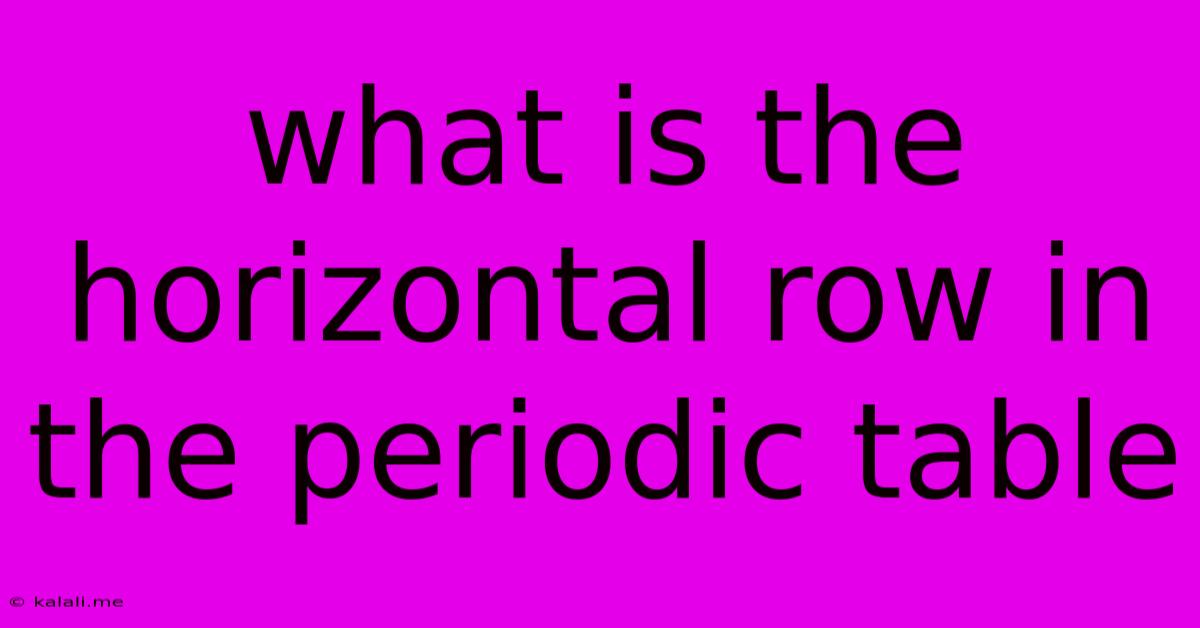What Is The Horizontal Row In The Periodic Table
Kalali
Jun 16, 2025 · 3 min read

Table of Contents
What is a Period in the Periodic Table? Understanding Horizontal Rows
The periodic table, that iconic chart of chemical elements, is organized in a specific way to reflect the properties of the elements. While many focus on the columns (groups), the horizontal rows also hold significant meaning. These horizontal rows are called periods, and understanding them is key to grasping the fundamental principles of chemistry. This article will delve into what periods represent, their significance, and how they relate to the electronic configuration of elements.
Understanding periods helps explain the trends in atomic radius, ionization energy, and electron affinity across the table. This is crucial for predicting the chemical behavior of elements.
What Defines a Period?
A period in the periodic table represents the principal energy level (or shell) to which the valence electrons of the elements in that row belong. In simpler terms, it indicates the highest energy level occupied by electrons in a neutral atom of that element. As you move across a period from left to right, the number of electrons in that outermost shell increases, influencing the element's chemical reactivity and other properties.
- Period 1: Contains only hydrogen (H) and helium (He), both with electrons in the first principal energy level (n=1).
- Period 2: Includes elements like lithium (Li), beryllium (Be), boron (B), carbon (C), nitrogen (N), oxygen (O), fluorine (F), and neon (Ne). These elements have electrons in the second principal energy level (n=2).
- Period 3: Elements like sodium (Na), magnesium (Mg), and chlorine (Cl) are found here, all sharing electrons in the third principal energy level (n=3).
- And so on... The periodic table continues with periods 4, 5, 6, and 7, each representing successively higher energy levels.
The Significance of Periodicity
The arrangement of elements into periods reflects the periodic recurrence of properties. As you move across a period, you'll notice a gradual change in properties, followed by a relatively abrupt return to similar properties at the beginning of the next period. This pattern is due to the filling of electron orbitals within each energy level.
For example, elements in the same group (column) often share similar chemical properties because they have the same number of valence electrons. However, elements within the same period show a variation in properties as their number of valence electrons changes.
Connecting Periods to Electronic Configuration
The period number directly correlates to the highest principal quantum number (n) in the element's electron configuration. This quantum number defines the energy level of an electron. The electron configuration describes how electrons are distributed among various energy levels and sublevels within an atom. Knowing the period helps predict the general electron configuration and therefore, some of the element's properties.
For instance, elements in period 3 will have electrons filling up to the 3rd principal energy level, while elements in period 4 will have electrons filling up to the 4th principal energy level. This is fundamental to understanding atomic structure and chemical bonding.
Period Trends and Their Implications
Understanding periods helps explain various periodic trends, including:
- Atomic Radius: Generally, atomic radius increases as you go down a group (adding a new energy level) and decreases as you go across a period (increasing nuclear charge).
- Ionization Energy: The energy required to remove an electron increases across a period (stronger nuclear attraction) and decreases down a group (increased atomic size and shielding).
- Electronegativity: The ability of an atom to attract electrons in a chemical bond increases across a period and decreases down a group.
In conclusion, periods in the periodic table are not just horizontal rows; they represent fundamental principles of atomic structure and are crucial for understanding the properties and behavior of elements. Grasping the concept of periods allows for a deeper comprehension of the periodic table and its predictive power in chemistry.
Latest Posts
Latest Posts
-
Reactive Power Formula In 3 Phase
Jun 16, 2025
-
Least Common Multiple Of 40 And 50
Jun 16, 2025
-
Nitrogen Used By Plants Is In The Form Of
Jun 16, 2025
-
Can You Take The Act As An Adult
Jun 16, 2025
-
What Is Unit Weight Of Water
Jun 16, 2025
Related Post
Thank you for visiting our website which covers about What Is The Horizontal Row In The Periodic Table . We hope the information provided has been useful to you. Feel free to contact us if you have any questions or need further assistance. See you next time and don't miss to bookmark.